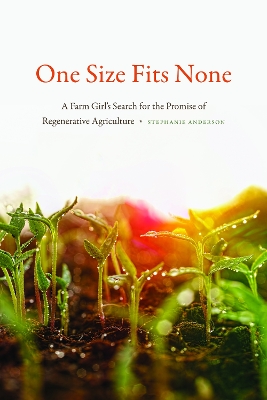Reviewed by annieb123 on
One Size Fits None is an exposition on agriculture and specifically what we as a society can do to change our systems and to what degree we can reverse the damage we've wrought to our biome. Author Stephanie Anderson grew up on a traditional midwest farm and began to question the agricultural production models during and after her college education. She makes a compelling case for the idea that not only is a sustainable paradigm necessary, we absolutely must also make changes to repair and compensate for previous damage by farming regeneratively.
Released 1st January 2019 by the University of Nebraska press, it's 312 pages and available in paperback and ebook formats.
The book is split into four main sections. The first section describes and provides insights into the traditional large-scale agricultural model. Farms are 'factories' producing generally one or two specialized crops at maximum speed and volume. The farms are run on such a huge scale that mechanized production is a necessity and sowing, weeding, maintenance and harvesting rely on large industrial machinery. Soil fertility and crop production are dependent on artificially applied chemical fertilizers which leads to decreased soil function which in turn increases reliance on more inorganic fertilizers. The author makes a compelling argument for the unsustainability of the treadmill that is the current system of agriculture. The question, then, is how to make a change.
The second section deals with a shift in paradigm to a regenerative holistic system. The model she discusses in the book is based on buffalo and other large herbivores grazing grassland in the midwest USA. The studies she cites showed an increase of soil health and plant diversity when organic methods are utilized which allows for a more complete cycle, since the insects and birds aren't killed off by using pesticides. I enjoyed reading about the farmer documenting the insect activity of the poop left by the buffalo (dung beetles process and drag the nutrients from the poo into the soil where it continues the cycle).
The third section of the book covers plant based organic methods of food production. I enjoyed the way the author writes about the farmers she profiles in the book. There is an emphasis on their methods, true, but she manages to emphasize their creativity, problem solving, and humanity at the same time.
The fourth section of the book brings the second and third together with a balanced smallholding model which incorporates both animals and plants in a cohesive whole. There is a common catchphrase in agriculture today 'Get big or get out'! This book makes a very compelling case why that is absolutely the wrong model if we want to repair the catastrophic damage we've done to the planet we all call home.
Even for people who aren't directly interested in engaging directly in food production, educating ourselves about food security and diversity is critically important now, before it's too late.
This book provides a wealth of further reading in the bibliography.
I remember reading Silent Spring decades ago and being absolutely electrified. This book gives me the same feeling. This is a very important book.
Five stars
Disclosure: I received an ARC at no cost from the author/publisher for review purposes.
Reading updates
- Started reading
- Finished reading
- 22 April, 2019: Reviewed
